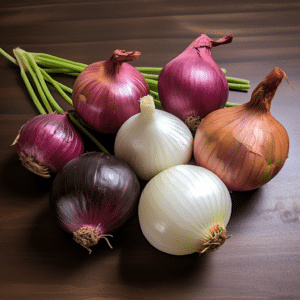Onions are a staple in many kitchens, adding flavor and depth to a wide range of dishes. They are also a rewarding crop for home gardeners, as they are relatively easy to grow and can be stored for long periods. This guide will provide you with all the information you need to successfully grow onions in your own garden.
Understanding Onions

Onions, scientifically known as Allium cepa, are part of the lily family, which also includes garlic, leeks, and chives. They are biennials, which means they take two years to complete their life cycle. However, they are usually harvested in their first year when their bulbs are fully formed.
There are several types of onions, each with its own unique flavor, color, and size. These include yellow onions, red onions, white onions, and sweet onions. Knowing the different types of onions and their growing requirements can help you choose the right variety for your garden.
Yellow Onions
Yellow onions are the most common type of onions and are known for their strong flavor. They are ideal for cooking and are often used in stews, soups, and roasts. Yellow onions require a long growing season and do well in full sun.
Red Onions
Red onions have a mild to sweet flavor and are often used in salads, sandwiches, and grilling. They prefer a slightly cooler climate and can be grown in both spring and fall.
How to Grow Onions

Growing onions can be done from seeds, sets, or transplants. Each method has its own advantages and disadvantages, and the best method for you will depend on your gardening goals and the climate in your area.
Regardless of the method you choose, onions require well-drained soil rich in organic matter. They also need a sunny location, as they require at least 6 hours of sunlight each day.
From Seeds
Growing onions from seeds gives you the most variety, as there are many types of onion seeds available. However, it also requires the most time and effort, as seeds need to be started indoors 8 to 12 weeks before the last expected frost.
From Sets
Onion sets are small, immature bulbs that are planted directly in the garden. They are the easiest and quickest way to grow onions, but they offer less variety than seeds.
Caring for Your Onions
Once your onions are planted, they require regular care to ensure a good harvest. This includes watering, fertilizing, and controlling pests and diseases.
Onions have shallow roots and therefore need frequent watering. However, they do not tolerate waterlogged soil, so it’s important to avoid overwatering. A good rule of thumb is to water when the top inch of soil is dry.
Fertilizing
Onions are heavy feeders and require regular fertilizing to produce large bulbs. A balanced fertilizer applied every few weeks can provide the necessary nutrients.
Pest and Disease Control
Onions can be affected by several pests and diseases, including onion maggots, thrips, and fungal diseases. Regular inspection of your plants and prompt action at the first sign of trouble can help keep your onions healthy.
Harvesting and Storing Onions
Onions are ready to harvest when their tops begin to yellow and fall over. At this point, you should stop watering and allow the onions to dry out for a few days before harvesting.
After harvesting, onions need to be cured or dried before storage. This involves laying them out in a well-ventilated area out of direct sunlight for 2 to 3 weeks. Once the outer layers are dry and the necks are tight, the onions can be stored in a cool, dry place for several months.
Conclusion
Growing onions can be a rewarding experience, providing you with a fresh supply of this versatile vegetable. With the right care and attention, you can enjoy a bountiful harvest from your own garden.
